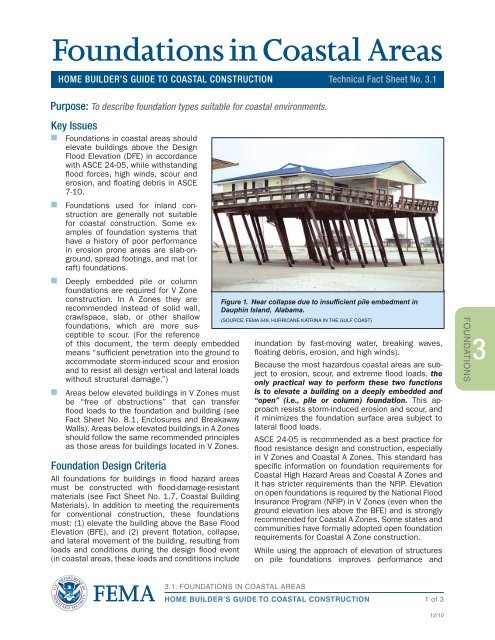FEMA P-499: Home Builder's Guide to Coastal Construction
FEMA P-499: Home Builder's Guide to Coastal Construction
FEMA P-499: Home Builder's Guide to Coastal Construction
Create successful ePaper yourself
Turn your PDF publications into a flip-book with our unique Google optimized e-Paper software.
Foundations in <strong>Coastal</strong> Areas<br />
HOME BUILDER’S GUIDE TO COASTAL CONSTRUCTION Technical Fact Sheet No. 3.1<br />
Purpose: To describe foundation types suitable for coastal environments.<br />
Key Issues<br />
n Foundations in coastal areas should<br />
elevate buildings above the Design<br />
Flood Elevation (DFE) in accordance<br />
with ASCE 24-05, while withstanding<br />
flood forces, high winds, scour and<br />
erosion, and floating debris in ASCE<br />
7-10.<br />
n Foundations used for inland construction<br />
are generally not suitable<br />
for coastal construction. Some examples<br />
of foundation systems that<br />
have a his<strong>to</strong>ry of poor performance<br />
in erosion prone areas are slab-onground,<br />
spread footings, and mat (or<br />
raft) foundations.<br />
n Deeply embedded pile or column<br />
foundations are required for V Zone<br />
construction. In A Zones they are<br />
recommended instead of solid wall,<br />
crawlspace, slab, or other shallow<br />
foundations, which are more susceptible<br />
<strong>to</strong> scour. (For the reference<br />
of this document, the term deeply embedded<br />
means “sufficient penetration in<strong>to</strong> the ground <strong>to</strong><br />
accommodate s<strong>to</strong>rm-induced scour and erosion<br />
and <strong>to</strong> resist all design vertical and lateral loads<br />
without structural damage.”)<br />
n Areas below elevated buildings in V Zones must<br />
be “free of obstructions” that can transfer<br />
flood loads <strong>to</strong> the foundation and building (see<br />
Fact Sheet No. 8.1, Enclosures and Breakaway<br />
Walls). Areas below elevated buildings in A Zones<br />
should follow the same recommended principles<br />
as those areas for buildings located in V Zones.<br />
Foundation Design Criteria<br />
All foundations for buildings in flood hazard areas<br />
must be constructed with flood-damage-resistant<br />
materials (see Fact Sheet No. 1.7, <strong>Coastal</strong> Building<br />
Materials). In addition <strong>to</strong> meeting the requirements<br />
for conventional construction, these foundations<br />
must: (1) elevate the building above the Base Flood<br />
Elevation (BFE), and (2) prevent flotation, collapse,<br />
and lateral movement of the building, resulting from<br />
loads and conditions during the design flood event<br />
(in coastal areas, these loads and conditions include<br />
Figure 1. Near collapse due <strong>to</strong> insufficient pile embedment in<br />
Dauphin Island, Alabama.<br />
(SOURCE: <strong>FEMA</strong> 549, HURRICANE KATRINA IN THE GULF COAST)<br />
3.1: FOUNDATIONS IN COASTAL AREAS<br />
inundation by fast-moving water, breaking waves,<br />
floating debris, erosion, and high winds).<br />
Because the most hazardous coastal areas are subject<br />
<strong>to</strong> erosion, scour, and extreme flood loads, the<br />
only practical way <strong>to</strong> perform these two functions<br />
is <strong>to</strong> elevate a building on a deeply embedded and<br />
“open” (i.e., pile or column) foundation. This approach<br />
resists s<strong>to</strong>rm-induced erosion and scour, and<br />
it minimizes the foundation surface area subject <strong>to</strong><br />
lateral flood loads.<br />
ASCE 24-05 is recommended as a best practice for<br />
flood resistance design and construction, especially<br />
in V Zones and <strong>Coastal</strong> A Zones. This standard has<br />
specific information on foundation requirements for<br />
<strong>Coastal</strong> High Hazard Areas and <strong>Coastal</strong> A Zones and<br />
it has stricter requirements than the NFIP. Elevation<br />
on open foundations is required by the National Flood<br />
Insurance Program (NFIP) in V Zones (even when the<br />
ground elevation lies above the BFE) and is strongly<br />
recommended for <strong>Coastal</strong> A Zones. Some states and<br />
communities have formally adopted open foundation<br />
requirements for <strong>Coastal</strong> A Zone construction.<br />
While using the approach of elevation of structures<br />
on pile foundations improves performance and<br />
HOME BUILDER’S GUIDE TO COASTAL CONSTRUCTION 1 of 3<br />
12/10<br />
FOUNDATIONS<br />
3


